Sweden
Everyone has their own associations with Sweden. Some people cannot help but think of the legendary ABBA hits, while others may be sad for the lovely fairy tales by Astrid Lindgren and Selma Lagerlöf. Hockey fans have a lot of respect for Tre Kronor, the national ice hockey team that has won 11 World Championships and two Olympic Games.
Villa, Volvo, and Vovve (a dog in Swedish) make a perfect model of life happiness in Sweden. And the Swedes have been very successful on the way to achieving it. Sweden has been included in the list of countries with the highest standard of living.

General Information
This Scandinavian country conquered our hearts long ago. And it is high time we got to know it better.
Sweden provides its citizens with free and high-quality education (from kindergarten to university) and medicine, and a range of many other social securities. However, such a delight is not that cheap. An average Swedish citizen pays 51% of their revenue as all sorts of taxes and charges.
Historical Background
Sweden is a monarchy where royal authority has existed since the 11th century. The first Swedish king was Olof Skötkonung, and during his reign, the country switched from pagan customs to Christianity.
The model of living of the Swedes was also changing. Economic relations were becoming more arranged, and traditional farming and cattle breeding were yielding profits.
The gradual strengthening of Sweden as a country led to its growing influence within the Scandinavian peninsula. Yet it was a part of the Kalmar Union under the rule of Denmark from 1397 to 1523.
Sweden seceded from the Union after the popular uprising led by the future king, Gustav Vasa, who was a patriot of his country and a brave reformer. During his rule, significant laws were adopted, which thus dramatically changed many spheres of the life of Sweden.
Apart from the economic, educational, and agricultural reforms, the country underwent the transition to Protestantism — a religious movement created and led by Martin Luther. Even nowadays, 62% of the Swedes adhere to the Church of Sweden, the largest Lutheran denomination in the world.
Between the 16th and the 18th centuries, the ambitions of Swedish kings that reigned in a mighty and developed state enabled Sweden to claim considerable expansion of its territories.
The Scandinavians won the thirty-year war with Germany, France, Poland, and Russia. As a result, Sweden massively expanded its territories at the expense of the Baltics and several regions of Poland and Germany.
Nonetheless, Swedish rule did not last long. Being at Great Northern War with Russia, Sweden suffered a defeat and lost more than had acquired before. Moreover, it had to concede Finland, Lettland, Estland and earlier conquered Polish and German lands. But the most disastrous consequence was squeezing Sweden from the Baltics. And therefore, there was no other way than to forget imperialist ambitions forever.
The path of the country has changed considerably since the 18th century. Military achievements remained in the past, and the Swedes concentrated on creating their own model of a state. And that model has been an example of the rule of law, comfort, and social security for the whole world.
Sweden has not been at war with any country since 1809. Adherence to the neutrality policy brings substantial dividends, which makes its well-developed economy and high profile more impressive in the international community.
Geography and Climate
The Kingdom occupies the east and south of Scandinavia and has terrestrial borders with Finland and Norway and a marine border with Denmark through the Skagerrak, Öresund, and Kattegat.
Apart from a part of the Scandinavian peninsula, Sweden occupies the islands of Gotland and Öland and thus is considered the third-largest country in Western Europe. It also borders the Baltic Sea.
The climate of the Kingdom is milder than in other Scandinavian countries due to the Gulf Stream, a warm ocean current flowing near the peninsula.
Weather depends on the region. For example, the northern part constitutes mountains and a subarctic climate. Winter is typical for the north: long, frosty, and with aurora polaris. Summer in the north of Sweden is short and cold. In June, the midnight sun comes and shines all day and night.

Kebnekaise mountain range in Sweden
A perfect time for touring the Kingdom is from June to August. Weather is comfortable, without heat and heavy rains, and air temperature is not higher than +25°C. It gets colder from the very first days of September when it begins raining heavily. So it is better to plan a vacation in Sweden for the summer.
At that time, the Swedes celebrate one of the main and most known holidays called Midsummer. On June 21 (summer solstice), the Swedes, their families, and relatives head out of the urban area for picnics. It is always a peculiar celebration in the background of picturesque, bright-green nature.
Big groups of people gather once a year to chat, eat, and dance together at the specially decorated pillar, the Midsummer symbol. The celebration is usually held on Friday, and people can finish their work in time.
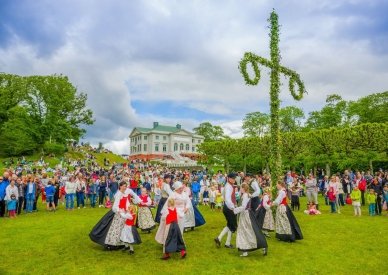
Midsummer celebrations in Sweden
The fans of active leisure, like extreme sports, come to Sweden in November and end the season in April. They are lured by the Swedish north-western mountain ski resorts (Åre, Sälen, Vemdalen). The local pistes are so safe and the infrastructure is so well-developed that people arrive there with children.
Language, Population, and Currency
Sweden has a population of 10.5 million people who speak Swedish as their official language.
However, the number of ethnic Swedes is increasingly becoming lower. The immigrants from the warring nations of the East, poor African countries, and Asia settled on the flourishing land of the Kingdom long ago. Sweden has turned into a nation of migrants, but in the 1930s, people emigrated en masse in the search of a better life.
Apart from the Swedes, there live also such indigenous people as the Saami, the Finns, and the Norwegians.
The biggest cities are the capital city Stockholm (961,000 people), Göteborg (605,000 people), Malmö (325,000 people), and Uppsala (150,000 people).
The official currency is the Swedish krona (SEK). The SEK-USD exchange rate is 1:0.11, and the SEK-EUR rate is 1:0.097.
Directions
The best option of getting to Sweden is travelling by air. The first thing is to check which airlines operate international flights there. Sweden has a connection with all major European cities as well as the UK. Besides, tourists may easily travel to Sweden from North America and other continents.
The busiest Swedish airports are Stockholm Arlanda Airport, Gothenburg Landvetter Airport, Stockholm Bromma Airport, Stockholm Skavsta Airport, and Stockholm Västerås Airport.

Accommodation
It might be surprising but in Sweden, there are fewer hotels than we can imagine (if to compare it with the other developed countries). For example, in Stockholm, there are only 180 hotels. And this number includes not only the hotels of different star-rating but also hostels, motels, boatels (re-equipped ships to accommodate tourists).
The other thing that comes as a surprise for the visitors of this Scandinavian kingdom is the cramped hotel rooms. Even in the five-star hotels, the rooms are small and over-furnished. There is a simple explanation. In big Swedish cities, luxury hotels are usually situated in the historic centre with high-density development. Every square metre counts, and thus huge buildings are an unattainable luxury.
Besides, a shared bathroom for several rooms is a common practice for many hotels. So it is necessary to pay attention to the offered facilities.
The prices for renting accommodation in Sweden, as in other countries, depend on the level of hotels, their remoteness from the centre, and other details.
For example, a standard double in a three-star hotel will cost €90, and in a four-star hotel — €115 - €120. The same price is for the stay in the boatel.
Luxury five-star hotels will cost not less than €230.
The hostel is the cheapest option, and the average price for a bed and breakfast is €60.
Though such prices might seem exorbitant, there is an explanation. The Swedes have a high standard of living and therefore have a corresponding salary. Moreover, the cost of accommodation almost always includes a very filling breakfast by the buffet system.
- Ibis Styles Stockholm Odenplan is a cheap hotel located in the capital city that offers plain rooms with separate bathrooms, air-conditioning, and other standard facilities, like free Wi-Fi and others. There is a restaurant, a business centre, and a laundry too. The cost of breakfast is also included in the general price.
- Stockholm Inn Hotell is a small hotel consisting of 22 rooms that offers a standard set of services with free Wi-Fi and breakfast.
- Göteborgs Mini-Hotel is a small, pet-friendly hotel in Göteborg with air-conditioning, separate bathrooms, and showers.
- Camp Viking is a cosy camping with separate houses and all the necessary amenities on the riverbank in the Gällö locality.
- H5 Hotel is a stylish two-star hotel in Helsingborg. There are comfortable beds, air-conditioning, and clean bathrooms. Wi-Fi and breakfast are free of charge.
The most convenient way is to book a room in advance, a month or two prior to the supposed trip. Then some discounts may be available.
Places to See
People who have got used to vivid impressions might perceive Sweden as a boring spot. And indeed, Swedish architecture is not distinctly different from the architecture of other European countries.
However, that is not entirely true. Not only does Sweden attract visitors with the empire- and Barocco-style palaces, but also with the memory of courageous Vikings, the pride in the myriad of scientific discoveries, and high technologies.
Stockholm
Swedish capital stretches across 14 islands where the multitude of museums, palaces, and castles have located. And the fans of partying will definitely love the abundance of nightclubs and discos.
Gamla stan is the island of narrow, cobblestone streets, where visitors may start their acquaintance with the old town of Stockholm, Sweden. The spirit of the ancient city is felt most strongly there.
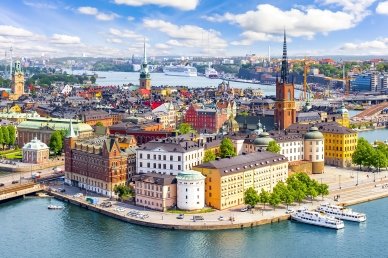
Gamla Stan - the historical heart of Stockholm
A trip to Kungsholmen, the other island of the Swedish capital, is an opportunity to see the Stockholm City Hall. Though it was constructed in 1923 and is not so ancient, it lures visitors to delve into the atmosphere of the old city.
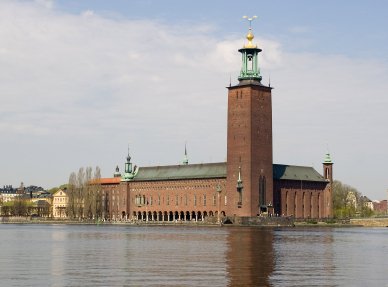
Stockholm City Hall
What would we do without one of the greatest discoveries of humanity — the postal service? The plentitude of main words would not have been said, the best feelings would not have been expressed if there had not been those envelopes with the enclosed letters and bright postage stamps.
The Postmuseum in Stockholm exhibits 17,000 items that tell the story of the past of the Swedish postal system. Though the postal service might seem boring, the Museum display is impressive. So you should definitely spend a couple of hours having a tour.
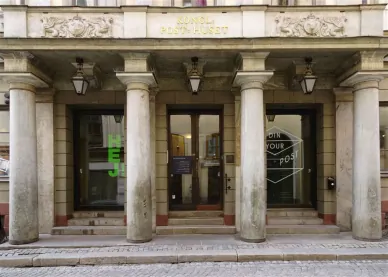
Postmuseum in Stockholm
Gothenburg
It is a city where visitors can eat delicious food, roam around the city parks, and spend every öre in the local shopping malls on Avenyn street.
If you want to have a blast and go clubbing, no other city than Gothenburg can offer such an ampleness of nightclubs.
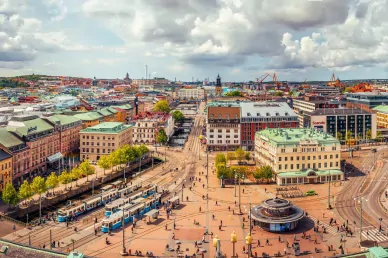
Gothenburg, Sweden
Malmö
In this city on the border with Denmark, nothing extraordinary can be encountered. But the tourists that visited Malmö enthusiastically reminisce about the only skyscraper in the city, which has become the local attraction. They are also impressed with green, well-kept parks and, without a doubt, the city nightclubs. The party animals will feel all the rapture there even if they do not understand Swedish.
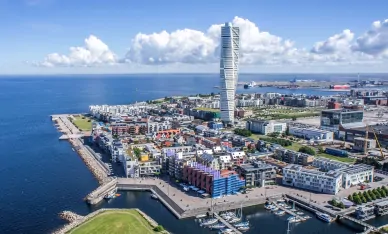
Malmö, Sweden
Food
Sure thing, a true acquaintance with Swedish cuisine is impossible without surströmming, a can of fermented herring. Not up to the challenge? So you have arrived in Sweden for no reason at all!
People open the cans, bulged from fermenting, only outside. The Swedes have a very appropriate approach to everything related to the feelings and perceptions of others. However, they hungrily eat this culinary delight with bread, boiled potatoes, and other garnishes.
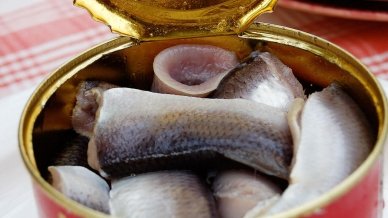
Swedish surströmming (fermented herring)
For those visitors who have not got used to experimenting with their tastebuds, Swedish cuisine has an abundance of other dishes with more habitual aromas and tastes.
For example, tourists may enjoy the meatballs called KÖTTBULLAR or pickled herring called a sill, which is a pure delight that does not necessitate any olfactory experiments.
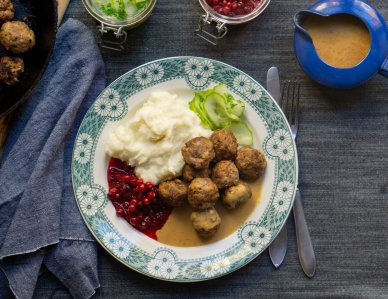
Meatballs called KÖTTBULLAR
If you end up as a guest at a Swedish family on Thursday, you will be definitely treated with a helping of thick pea soup with pancakes.
The other truly Swedish dish is räksmörgås or a prawn sandwich that is made of a slice of bread covered with the prawn salad, boiled eggs, cucumbers, lettuce, and tomatoes with sour cream. The dish is delicious, filling, and really fattening.

Swedish räksmörgås
Knäckebröd is a Swedish crispbread that can be considered a typically Swedish food. As a rule, they are served with butter, different vegetables, pieces of boiled eggs, and caviare. Knäckebröd is not a very exquisite dish as it is an everyday meal of the Swedes. However, it can also be very suitable for treating the guests.

Swedish crispy bread Knäckebröd
By the way, in Sweden, it is unacceptable to come without an invitation. So if you want to visit even your close friends, arrange this a couple of days in advance.
And at last, lingonberry jam is the other treat from Sweden consumed as an indispensable ingredient with any dish. At least, a portion of jam is always on the table together with patties, tenderised steaks, blodpudding (blood sausage), morning pancakes, or other sweet pastry.
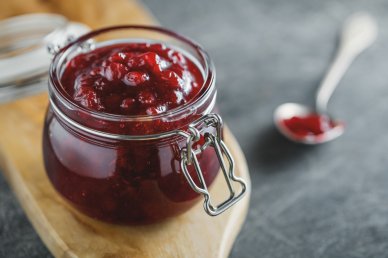
Lingonberry jam
Sweden is a must-see country for everyone seeking something synonymous with the word ‘comfort’. This land is an embodiment of care about a person in every detail. And yes, Sweden is comfort, and vice versa — comfort is Sweden.
FAQ
What is the total land area of Sweden?
The total land area of Sweden is approximately 450,295 square kilometers.
What type of government is Sweden under?
Sweden is a constitutional monarchy with a parliamentary democracy. The monarch is the head of state, but the Prime Minister is the head of government.
Is Sweden a full EU member?
Yes, Sweden is a full member of the European Union.
What is the capital of Sweden?
The capital of Sweden is Stockholm.
What is Sweden's population?
Sweden's population is about 10.5 million people.
What language is mostly spoken in Sweden?
The official language and the one most commonly spoken in Sweden is Swedish.
What is the main religion in Sweden?
The main religion in Sweden is Christianity, specifically Lutheranism.
Which is the currency of Sweden?
The currency of Sweden is the Swedish Krona (SEK).
Does Sweden have a good economy?
Sweden has a high-income economy known for its high standard of living, strong welfare system, and a modern, diverse industrial base.
Is Sweden good in education?
Sweden is known for having a high-quality education system, with free education and a strong emphasis on equal opportunities.
Is Sweden's healthcare system good?
Sweden provides universal healthcare to its citizens, which is known for being of high quality and largely funded by taxes.
What is Sweden most famous for?
Sweden is famous for its beautiful landscapes, innovative design and technology, ABBA, IKEA, Volvo, and its contributions to music and literature. It's also known for its progressive social policies and environmental consciousness.
Is Sweden very expensive?
Sweden is considered somewhat expensive in terms of living costs, especially in major cities like Stockholm, Gothenburg, and Malmö.
Is Swedish a good place to live?
Sweden is often considered a great place to live due to its high standard of living, strong welfare system, low crime rates, and commitment to equality and environmental sustainability.







